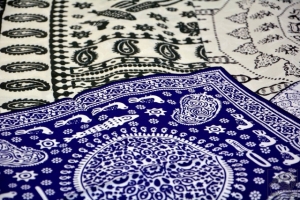Blue Tablecloths in Georgia's Supra Culture
Ornamental tablecloths are one of the most beautiful things people can make, made of almost any material.
Some are mainly ornamental coverings, and some use delicate fabrics like embroidered silk. At the end of the 17th century and beginning of the 18th century in Georgia cotton tablecloths were painted in various hues of blue.
These products are known as Lurji supra, the “blue tablecloths.” The patterns are various in style and theme, depending on the craftsman. Georgian artists used different figures such as flora-fauna, household dishes, different men and women and more as inspiration.
Blue tablecloths are widespread and you can often find them in wedding ceremonies or religious holidays and in other feasts. These blue tablecloths were produced by Georgian factories at the end of the 20th century and have become an aesthetic symbol of the country.
As the screen-printing technique improved, production grew and met increasing market demand from both tourists and locals. But when plants and factories closed in Georgia as a result of the collapse of the Soviet Union, the production of blue tablecloths stopped.

For many years artisans had been trying to restore the tradition and in 2010 Tbilisi State Academy of Arts established a scientific-research laboratory of blue cloths, named Lurji Supra in order to study the century-old blue tablecloths. The founders were Tinatin Kldiashvili and Ketevan Kavtaradze. Students of Tbilisi State Academy or Art have had the chance to participate and have represented Georgia and shared their work at the Strasbourg Christmas Market, and the Artigiano in Fiera international craft fair in Milan.
Today students are able to use ancient inspiration to create their own designs as well, keeping alive a small but much loved element of Georgian culture.
Nina Ioseliani











